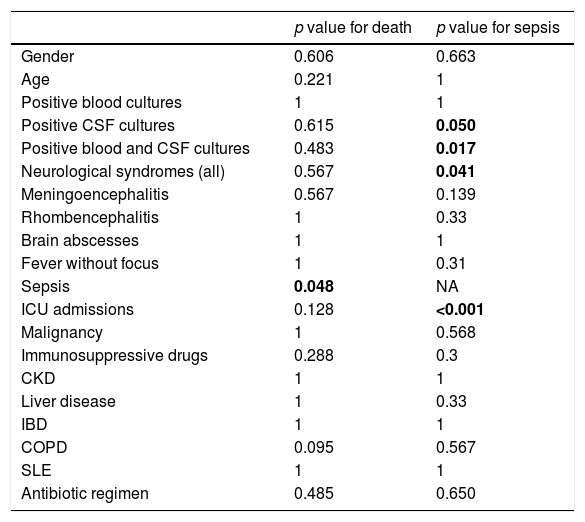We describe and analyze Listeria-related demographics and clinical features to determine the predisposing conditions for severe infections.
MethodsWe performed a retrospective study using positive isolation of Listeria monocytogenes from blood, cerebrospinal fluid, and other organic fluids. Electronic health records were used to determine the epidemiological and clinical features of infections caused by L. monocytogenes. Mortality and sepsis were considered dependent variables in the statistical analyses.
ResultsWe included 41 patients in an observation period of 15 years (2003–2018), with an annual incidence rate of 1.3 cases per 100,000 population. Three main population profiles were identified: newborns, pregnant women, and other adults (17.1%, 12.2%, and 82.9%, respectively). Neuroinvasive infection was present in 17 patients (41.5%). In both univariate and multivariate analyses, neurological infections, whether meningoencephalitis, rhombencephalitis, or brain abscesses, were the main risk factors for severe forms of Listeria-related infections (odds ratio 1.8, 95% CI 1.52–2.14, p=0.01). Malignancies, whether solid tumors or hematological neoplasms, immunosuppression, and chronic diseases were not related to either mortality or severe clinical syndromes.
ConclusionInfections caused by L. monocytogenes were uncommon but could cause severe sepsis and mortality, especially in susceptible populations. Our study focused on neurological involvement and severe invasive forms of listeriosis. Neuroinvasive forms were the most important risk factors for severe illness but not for mortality.
Describir y analizar las características demográficas y clínicas de las infecciones por Listeria para determinar los factores predisponentes para infecciones severas.
MétodosDiseñamos un estudio retrospectivo utilizando los aislamientos positivos de Listeria monocytogenes en sangre, líquido cefalorraquídeo u otros fluidos orgánicos. Se obtuvieron los registros electrónicos para conseguir las características clínicas y epidemiológicas de las infecciones causadas por L. monocytogenes. Mortalidad y sepsis fueron las variables dependientes en los análisis estadísticos.
ResultadosSe incluyeron 41 pacientes en un período de 15 años (2003-2018), con una incidencia anual de 1,3 casos por cada 100.000 habitantes. Identificamos tres perfiles de población: neonatos, mujeres embarazadas y resto de adultos (el 17,1%, el 12,2% y el 82,9%, respectivamente). Las formas neuroinvasivas se identificaron en 17 pacientes (41,5%). Tanto en los análisis univariados como en los multivariados, las infecciones neurológicas, bien meningoencefalitis, rombencefalitis o abscesos cerebrales, fueron los principales factores de riesgo para considerar formas severas de infección por Listeria (odds ratio 1,8; IC 1,52-2,14, p=0,01). Las neoplasias sólidas o hematológicas, la inmunosupresión o las enfermedades crónicas no estuvieron relacionadas ni con la mortalidad ni con la presencia de severidad en la infección.
ConclusiónLas infecciones causadas por L. monocytogenes son infrecuentes, pero son causa de sepsis severa y mortalidad en poblaciones susceptibles. Nuestro estudio estuvo dirigido a la infección neuroinvasiva y otras formas graves. La forma neuroinvasiva fue el factor de riesgo más importante asociado a la infección severa, pero no a la mortalidad.












